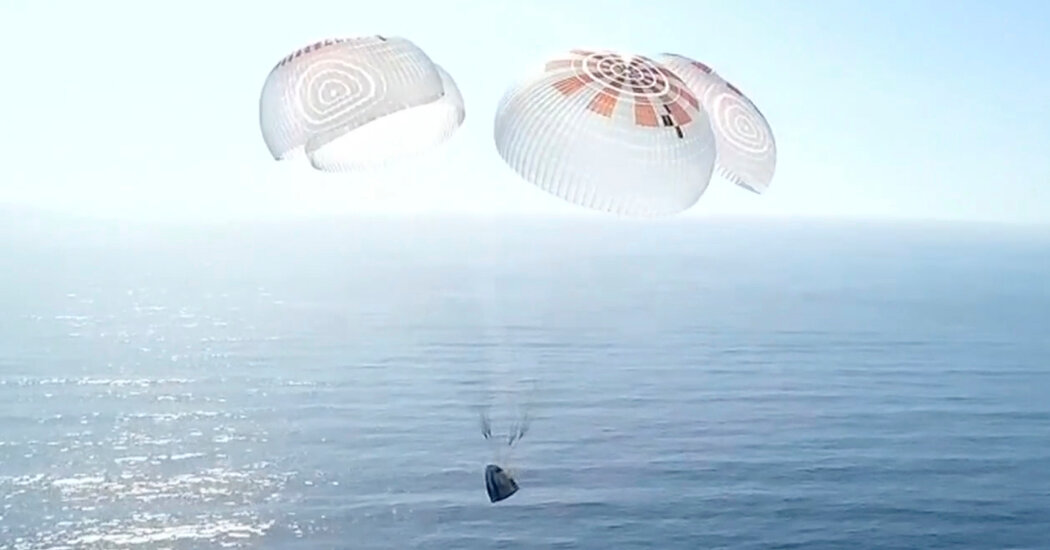Four private astronauts ended a mission in a SpaceX vehicle on Friday by splashing down in waters near Oceanside, Calif.
It was the first time the company had brought people back to Earth in the Pacific Ocean, after six years of its Dragon capsule splashing down off Florida in the Atlantic Ocean or the Gulf of Mexico.
The Fram2 mission had circled the Earth for four days in a north-south orbit. The journey was the first time people have been able to look down directly at the North and South Poles from orbit.
SpaceX moved its operations to the Pacific to eliminate the problem of Dragon debris falling in random parts of Earth. The Pacific is the biggest pool of water on the planet, and the weather along the West Coast of the United States tends to be pretty nice, too, which provides more days favorable for the return of astronauts.
The first SpaceX astronaut mission, a test flight in May 2020 with Douglas Hurley and Robert Behnken of NASA aboard, launched to the International Space Station. Just over two months later, they returned to Earth, splashing down in the Gulf waters off Pensacola, Fla. This was the first flight using SpaceX’s upgraded Dragon 2 capsule design.
Fourteen other astronaut missions followed — nine flights financed by NASA, five private ones — as well as 10 cargo missions for NASA taking equipment and supplies to the International Space Station. All splashed down safely off Florida.
However, pieces of the spacecraft’s trunk — the cylindrical segment below the capsule that is jettisoned before re-entry — were coming down in unexpected places: a sheep field in Australia; a farm in Saskatchewan, Canada; and a hiking trail in North Carolina.
No one was hurt, and no property damage occurred. Hoping for continued good luck, however, would not be considered adequate protection from a continuing rain of space debris.
SpaceX said it had anticipated that the spacecraft’s trunk would completely burn up in the heat of re-entry. Because that turned out not to be the case, SpaceX last year announced changes that it planned to make for the Dragon landings.
First, the trunk would be jettisoned later in the return journey, after the spacecraft had fired its thrusters to drop out of orbit. That enables aiming of the debris, and the Pacific Ocean provides a large, unpopulated expanse of water where the debris will not pose a danger to people.
Before these changes, the Dragon trunk remained in orbit for weeks to months with no way to predict where it would re-enter.
For NASA, it will also help scheduling of its missions because of calmer weather in the Pacific.
In October, the return of a Dragon capsule with four astronauts from the space station was delayed for two weeks, first by Hurricane Milton, which swept over Florida, and then by continuing stormy conditions and choppy seas.
SpaceX had moved the Dragon landings in Florida in part to meet NASA requirements for faster processing of science experiments coming back from space. It will also take SpaceX longer to transport the capsules back to Florida for preparations for its next flight.
The last East Coast landing occurred last month with the return of a NASA mission from the space station that brought back two NASA astronauts, Suni Williams and Butch Wilmore. Their stay in orbit was stretched to an unplanned nine months because of problems with the Boeing Starliner spacecraft they had taken to orbit. The flight ended with a whimsical moment as a pod of dolphins investigated the spacecraft and the boats that had traveled to recover it.
For the Fram2 mission this week, Chun Wang, an investor who made his fortune in blockchain and cryptocurrency mining, paid an undisclosed amount. He selected three people to accompany him: Jannicke Mikkelsen, a Norwegian filmmaker; Rabea Rogge, a robotics researcher from Germany; and Eric Philips, an Australian explorer who specializes in expeditions to the polar regions.
Mr. Wang named the mission after the Fram, a Norwegian ship that explored the Arctic in the 19th century.
He provided a series of updates from orbit, 270 miles above the Earth’s surface, including the queasy beginning.
“Space motion sickness hit all of us — we felt nauseous and ended up vomiting a couple of times,” he wrote on X. “It felt different from motion sickness in a car or at sea. You could still read on your iPad without making it worse. But even a small sip of water could upset your stomach and trigger vomiting.”
He said that the motion sickness was gone by the second morning.
Astronaut splashdowns in the Pacific were common in an earlier era of spaceflight, with most of NASA’s Apollo missions landing there.
Landings in the Pacific are also a return to the past for SpaceX. Twenty missions using an earlier version of the company’s Dragon capsule to carry cargo to the space station from 2012 to 2020 all splashed down there.
No word on whether the West Coast dolphins will be just as curious.


